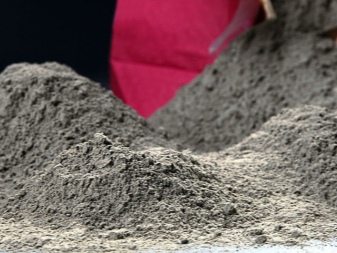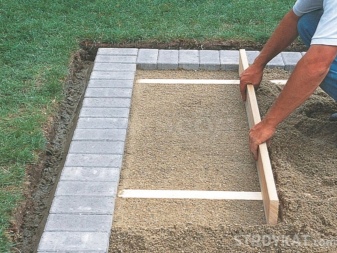Description of paving slabs for paving slabs and its application

Gartsovka is a building material used when laying paving slabs. From the material in this article, you will learn what it is, what it is, how it is applied. In addition, we will tell you how the do-it-yourself laying technology is carried out on a porter.


What is it and where is it applied?
Gartsovka is a two-component mixture of filling and binder. Its basis can be quartz sand, flour, expanded clay, marble or calcium. The binding component is gypsum, clay, lime, cement.
Gartsovka and cement mortar are not the same thing. This is a dry laying mixture used in the arrangement of sidewalk paths, which serves as a carrier layer. In addition, the material is used in the construction industry. Initially, there is no water in its composition.
With its help, they arrange floating floors, level bases of any type (including aerated concrete). It is used as a pulling putty for walls and ceilings. It is poured onto the base under the paving slabs.


Gartsovka has a high adhesion to the base. This is a cheap building material in comparison with the compositions of famous brands. It is environmentally friendly and has a long service life. Allows you to restore surfaces to their original appearance.
The material is picky about proportions. It is not done by eye, since this reduces the quality properties and durability of the used product. It is easy to work with, it is used for puttying, plastering, masonry.
It is used to rub the tile joints, cracks in stone and wooden foundations. It is bought for laying brick walls.


Species overview
Gartsovka can be classic and complex. In the first case, it is a material of 2 components. In the second, several ingredients can be included in it (3-5). At the same time, a new binder is added to the binder and filler.
The type of garters determines its use. Paving slabs are usually laid on a 2-component composition of sand and cement. When you need to pave the paths with paving stones or a large stone, you have to use a complex mixture.
Gartsovka is classified according to the type of strength. Based on this, the degrees M-1, M-2, M-3, M-4 are distinguished. The numbers indicate the number of parts of the filler in relation to the binder. For example, the M2 brand means that the construction raw materials contain one part of cement and two parts of sand.


In addition, the mixture can be light or heavy. The grain size of the lightweight gartsovka does not exceed 0.125 cm. The heavy variety includes components with a grain size of 0.2 cm or more.
Gartsovka can be industrial and "home" made from the necessary components with your own hands... The proportions of the material are selected based on the required strength of the final composition.
The industrial material is sold in packs of 2, 5, 10, 25, 50 kg. In addition, it is found in the form of 1-ton "big bags".


How to cook?
The compositions of the gartsovka can vary depending on the type of components taken. Sample mix options can be found in the table.
|
Concrete grade |
Mass composition of c: p: u (kg) |
Volumetric composition per 10 liters of cement, p: w (l) |
Amount of concrete from 10 liters of cement (l) |
|
M 100 |
1: 4,6: 7 |
41: 61 |
78 |
|
M 150 |
1: 3,5: 5,7 |
32: 50 |
64 |
|
M 200 |
1: 2,8: 4,8 |
25: 42 |
54 |
|
M 250 |
1: 2,1: 3,9 |
19: 34 |
43 |
|
M 300 |
1: 1,9: 3,7 |
17: 32 |
41 |
|
M 400 |
1: 1,2: 2,7 |
11: 24 |
31 |
|
M 450 |
1: 1,1: 2,5 |
10: 22 |
29 |

It is not difficult to make a gartsovka. For this, components are purchased and the necessary tools are prepared. Cooking technology consists in the correct combination of dry components. Liquid is not included in the composition at all. If you add it, the gartsovka becomes a typical sand-cement mortar for laying tiles.
First, a filler (sand, calcium) is sieved onto the leveled surface. The presence of lumps and stones is excluded. Lime and cement are added from above, all materials are mixed.
Within 4-6 hours, the dry mixture should be mixed with water. This is done after styling.


The material is poured directly onto the construction site. It is also mixed there in the given proportions. If it is necessary to create a reliable and durable base for laying tiles, small crushed stone or granite chips are used instead of sand. Such a covering is suitable for areas of high traffic and paving areas of increased load.
The ratio of sand and cement when preparing the working material must be correct. If there is little cement in the composition, over time, vegetation will appear between the tiles, the root system of which will destroy the roadbed. If you use too much cement, the paving will crack.

Consumption calculation
The consumption rate depends on the type of facing work. When plastering wall ceilings, the consumption of plastering is approximately 1.4-1.8 kg per m2 with an average layer thickness of 1 mm. When laying paving slabs, the calculation norms are different.
The approximate material consumption is about 5 kg / m2 when the joint thickness reaches 3 mm. When calculating the required amount of material, the indicators of each ingredient, the total paving area and the thickness of the laid layer are taken into account.

Tips for laying tiles
Gartsovka is used as a dry cushion when paving sidewalks. The technology of this paving involves pouring the mixture onto the prepared base. To do this, they initially pull out a pit, get rid of roots, stones and debris, then ram it with a slight slope for the drain.
After that, sand is poured on the bottom, rammed, moistened with water. Next, a layer of rubble is poured, creating drainage. After compaction of crushed stone, waterproofing is laid. After this stage, the technology of paving with the use of paving stones may differ.
In the first case, a layer of hartsovka is placed on the waterproofing, onto which the tile blocks are subsequently immersed. In the second, they first equip a concrete base with reinforcement. And only after that they use a porter. In addition, the grinder is used to seal the butt joints between the tiles. For this, the seams are filled with it and sealed with water.

Then the seams are re-filled with dry mixture, since it tends to shrink. It must be rammed, and, like all base layers, this is done with a slope. The dry mortar must be tamped before paving, using a special technique (for example, a vibration machine).
The thickness of the dry cushion under the tiles can vary, which is related to the weight and size of the sides of the paving stones used and the planned load on the base. When laying a typical tile, the thickness of the layer of the grinder should be at least 5 cm. Based on the parameters of the modules, it can reach up to 70 mm.
To achieve a perfectly flat surface of the punching layer, the mixture is leveled with the rule of lighthouses or with a long board. After preparing the pillow, you can lay the tiles. Each stone to be laid is immersed in the mixture so that its height is 1-2 cm higher than the curb.
If necessary, trim it with a rubber mallet.

During the installation, the solidity of the paving is constantly checked using a long strip or cord. All elements must be at the same height.
Dry cladding is suitable for paving areas where the soil has a low moisture absorption rate. After spilling the tiles from the hose, the grinder reliably connects the cladding into a monolithic coating. And thanks to the curb stones, the possibility of side elements shifting is excluded.

How to cook a gartsovka, see the video.













The comment was sent successfully.